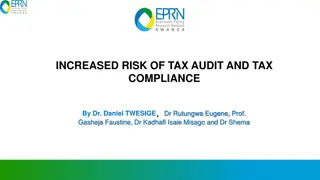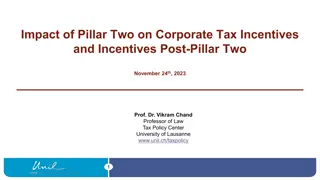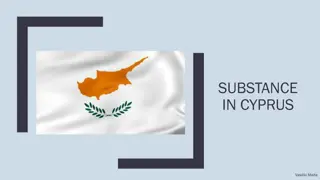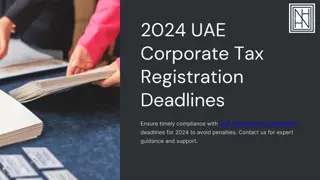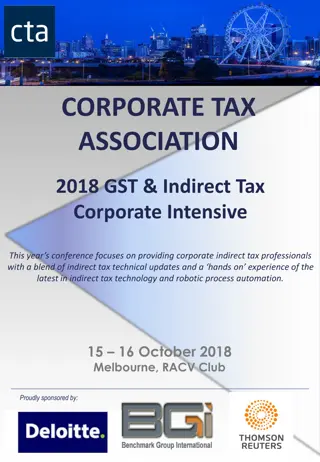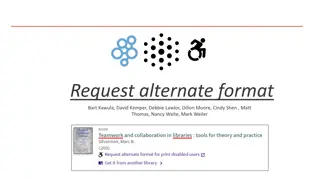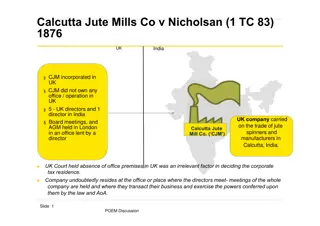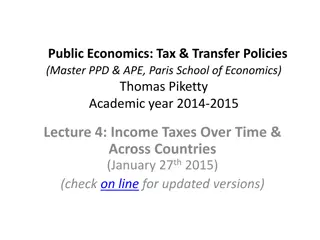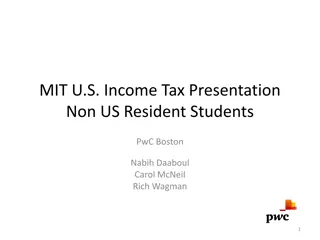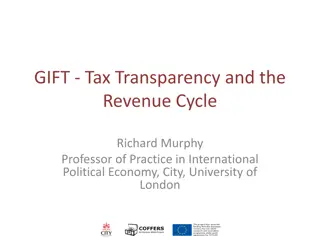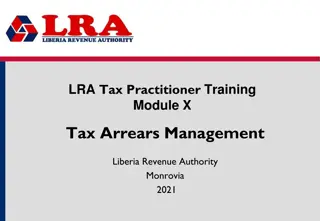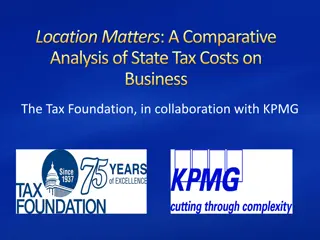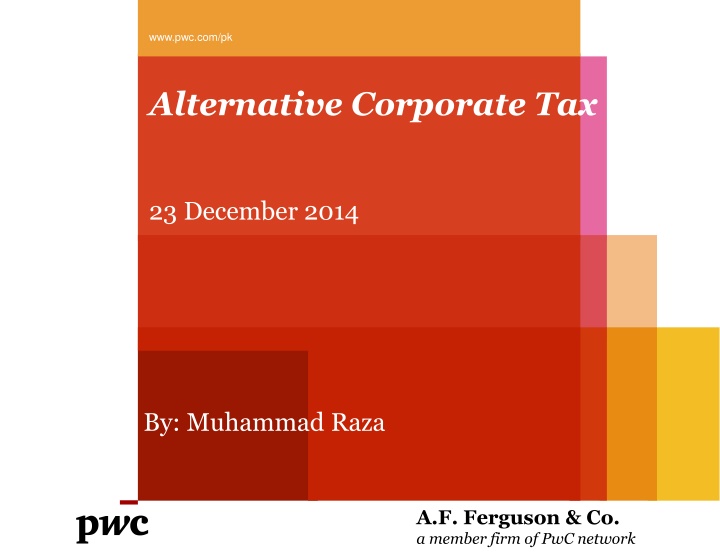
Alternative Corporate Tax and Its Implications
Learn about Alternative Corporate Tax (ACT), its introduction, international examples, the effect of the non-obstante clause, and more. Explore how ACT aims to discourage tax avoidance strategies by companies and the impact it has on taxpayers and tax planning.
Uploaded on | 1 Views
Download Presentation

Please find below an Image/Link to download the presentation.
The content on the website is provided AS IS for your information and personal use only. It may not be sold, licensed, or shared on other websites without obtaining consent from the author. If you encounter any issues during the download, it is possible that the publisher has removed the file from their server.
You are allowed to download the files provided on this website for personal or commercial use, subject to the condition that they are used lawfully. All files are the property of their respective owners.
The content on the website is provided AS IS for your information and personal use only. It may not be sold, licensed, or shared on other websites without obtaining consent from the author.
E N D
Presentation Transcript
www.pwc.com/pk Alternative Corporate Tax 23 December 2014 By: Muhammad Raza A.F. Ferguson & Co. a member firm of PwC network
Agenda Section 1 Section 2 Section 3 Section 4 Section 5 Section 6 Section 7 Section 8 Section 9 Section 10 Introduction to ACT International examples Effect of non-obstante clause Effective year & retrospective application Taxpayers covered by ACT Exclusions Computational aspects Carry forward of ACT FBR s computational examples Issues emanating from ACT Q & A PwC 2
Introduction to ACT - A new section 113C titled as Alternative Corporate Tax has been introduced through Finance Act, 2014, which starts with a non-obstante clause i.e. Notwithstanding anything contained in this Ordinance (Income Tax Ordinance, 2001) - Applicable for tax year 2014 and onwards - Tax payable by a Company will be higher of the CorporateTax (generally includes minimum and final taxes apart from certain exceptions) or Alternative Corporate Tax (17% of Accounting Income subject to certain adjustments and exclusions) - Rationale for introduction of ACT was explained in the Salientfeatures of Budget documents to discourage perpetual declaration of losses or very low income using tax avoidance means by Companies . - The Finance Minister in his Budget Speech also mentioned that ACT is being introduced for corporate cases where taxable income is usually far less than accounting income due to careful tax planning to avail all possible avenues of tax avoidance technically. PwC 3
International examples - India 18.5% of book profits of the Company (termed as adjusted accounting profits). - Argentina Applicable at 1% of the value of fixed and current assets. - Mexico 17.5% of Flat Tax Base computed on the basis of certain cash inflows and outflows - Austria Minimum amounts of tax have been prescribed for certain types of companies. - Mauritius 7.5% of book profits or 10% of dividends, whichever is higher. Except for Mauritius, in all the above cases, adjustment is allowed for next 10 years. PwC 4
Effect of non-obstante clause - The provisions of section 113C only have an overriding effect over other provisions of the Income Tax Ordinance, 2001 - In case of any conflict between the provisions of section 113C and any other provision of the Income Tax Ordinance, 2001, the provisions of section 113C will prevail - If, however, there is a conflict between section 113C and any other provision of a Special Statute, the provisions of section 113C will remain subservient to the provisions of such Special Statute. Much would, however, depend upon the language of such Special Statute and the nature of conflict. - The provisions of section 113C are in the nature of Self Contained code . Other provisions of the Income Tax Ordinance cannot be applied automatically except to the extent permitted by Section 113C itself. PwC 5
Effective year & retrospective application - Specifically mentioned to be applicable for tax year 2014 and onwards. - Not a one-time levy but also intended to be applicable for subsequent tax years. - Companies following Special Tax Years already ended before introduction of section 113C are affected by this levy. - Even for Companies following June 30 as their year-end are also affected by this law as all advance tax payments were already made in accordance with normal provisions. - ACT, thus, has a retrospective effect for tax year 2014 by way of expressed language and not by way of any intendment. - Constitutional validity of the retrospective application is to be decided by the Courts. It is, however, generally believed that a retrospective law is valid if made through expressed legislation. PwC 6
Taxpayers covered by ACT - ACT is only applicable on a Company and as such, all other categories of taxpayers, such as Individuals and Association of Persons are not covered. - Unlike section 113, ACT is also applicable on non-resident companies. - Section 113C itself does not define the term Company and, therefore, the term has to be construed as per section 80 to include the following. (a) Locally incorporated Companies, body corporates, Small Companies (b) Modarabas (c) Foreign companies (d) Co-operative societies, Finance societies and other societies (e) Non-profit organisations (f) Trust, an entity or body of persons established or constituted by any law (g) Foreign associations declared by FBR as a Companies (h) Provincial Governments (i) Local Governments in Pakistan PwC 7
Companies not covered by ACT - ACT is specified to be non applicable on Taxpayers chargeable to tax in accordance with the following provisions of Income Tax Ordinance, 2001 (a) Fourth Schedule (Insurance Companies) (b) Fifth Schedule (Mining Companies) (c) Seventh Schedule (Banking Companies) - By implication, ACT is also not applicable on following companies: (i) Companies setting up an Industrial Undertaking between July 1, 2014 to June 30, 2017 and subject to certain conditions, eligible for a reduced tax rate of 20% for a period of five years (ii) Non-profit organisations and certain trusts and welfare institutions eligible for 100% tax credit under section 100C (iii) Companies eligible for 100% tax credit under section 65D not having any other income (iv) Companies not deriving any income other than exempt or certain incomes subject to final taxation or Capital Gains under section 37A Non-resident companies not having any presence in Pakistan (v) PwC 8
Computation of ACT - ACT is defined as the tax at a rate of 17% of a sum equal to AccountingIncome as reduced by certain specific adjustments. - AccountingIncome is defined as the accounting profit before tax for the tax year, as disclosed in the financial statements, excluding share from the associate recognised under equity method of accounting. - Following amounts are also excluded from accounting income for computing ACT. (a) exempt income (b) income subject to tax under section 37A (capital gains on securities) (c) income subject to final taxation under section 148(7) Imports, Section 150 (Dividends), Section 153(3) Resident Suppliers and Contractors, Section 154 (Exports), Section 156 (Prizes 233(3) Brokerage and Commission & winnings) and section PwC 9
Computation of ACT (d) income subject to tax credit under sections 65D and 65E (equity investment in certain Industrial Undertakings) (e) income subject to tax credit under section 100C (NPOs and certain trusts & welfare institutions); and (f) income of the Company subject to reduced rate of tax under newly inserted clause 18A of Part II of the Second Schedule - The therefrom (as mentioned in (a) to (f) above) is to be treated as Taxable income for the purposes of section 113C. sum equal to accounting income less any amount to be excluded - For the purposes of determining the AccountingIncome , expenses are required to be apportioned between the excludedamounts and the balance accounting income (being treated as taxableincome ). FBR s Circular suggests the apportionment on turnover basis. - The Commissioner is empowered to make adjustments and proceed to compute accounting income as per historical accounting pattern after providing an opportunity of being heard. - Tax credit under section 65B (on investment in BMR Plant & Machinery) is allowed against ACT. PwC 10
Corporate Tax Defined as total tax payable by the Company, including- (a) tax payable on account of minimum tax (e.g. Minimum tax on turnover under section 113, Minimum tax on builders under section 113A, Minimum tax on land developers under section 113B, minimum tax under section 148(8) on importers of edible oil and packing material, minimum tax under clauses 56B, to 56G for certain persons opting to be taxed under normal tax regime) (b) final taxes payable under any provision of the Ordinance but not including those mentioned in Section 8 (FTS and royalty of non-resident persons not having Permanent Establishments in Pakistan, incomes of non-resident shipping & airlines, dividend income) Following taxes are excluded: - Section 161 (tax recovered from payer due to default in withholding tax compliance) - Section 162 (tax recovered from the recipient due to withholding tax non- compliance of payer) - Default Surcharge or penalty - ACT payable under section 113C PwC 11
Carry forward of ACT - The excess of Alternative Corporate Tax paid over the Corporate Tax payable for the tax year is to be carried forward and adjusted against the tax payable under Division II of Part I of the First Schedule for following year. - If the excess tax is not wholly adjusted the unadjusted amount is to be carried forward to the following tax year and so on, however, the excess cannot be carried forward to more than ten tax years immediately succeeding the tax year for which the excess was first computed. - The entitlement to carry forward minimum tax under section 113 will remain unaffected by ACT. - If Corporate Tax or ACT is enhanced or reduced as a result of any amendment or as a result of any order, the excess amount to be carried forward will be adjusted accordingly. PwC 12
FBRs computational examples Example 1 Explanation of carried forward minimum tax & ACT Corporate Tax (excluding minimum tax) (A) Rs 100 Minimum tax under section 113 (B) Rs 140 ACT (C) Rs 200 Corporate Tax under section 113C (D=A+B) Rs 140 Excess amount of ACT over Corporate Tax carried forward for next ten tax years (C-D) 60 Excess amount of Minimum tax carried forward for next five years (B-A) 40 PwC 13
FBRs computational examples Example 2 Apportionment of expenses Export Sales FTR Contract receipts FTR Dividend receipts FTR Exempt income Business income Total receipts 20 30 10 10 130 200 Total expenses Accounting Income as per accounts Taxable Income 50 150 25 PwC 14
FBRs computational examples Example 2 Apportionment of expenses Computation of Accounting Income for ACT calculation Total receipts in the accounts Total receipts to be excluded under section 113C(8) Total receipts pertaining to accounting income for ACT (A) 200 (B) 70 (C) 130 Apportionment of Expenses for ACT Percentage of receipts of accounting income Expenses to be apportioned (65% of total expenses) Accounting income for ACT (D=C/A) 65% (E) 32.5 (C-E) 97.5 PwC 15
FBRs computational examples Example 2 Apportionment of expenses Computation of tax liability Tax liability under ACT @ 17.5% of Accounting Income Corporate tax @ 34% of Taxable Income Final Tax liability on exports, contracts & dividends Total Tax payable (A) 16.575 (B) 8.5 (C) 3 (A+C) 19.575 Certain observations in the above example - All expenses between final tax and normal income have been apportioned on receipts basis - Final taxes have been added over and above ACT whereas the same should have been made part of Corporate Taxes (other than dividend related tax) PwC 16
FBRs computational examples Example 3 Brought forward of tax losses Taxable income for the year Brought forward losses Taxable income / loss after losses Accounting Income as per section 113C 200 (300) (100) 250 Computation of tax liability Corporate Tax @ 34% of Taxable Income Tax liability under ACT @ 17% of 250 Tax liability (higher of above) 0 42.5 42.5 PwC 17
Issues emanating from ACT - Discriminatory to Corporate Sector which is documented and subject to Corporate Regulatory requirements whereas other taxpayers such as sole proprietors and AOPs are not subject to ACT regime. The possibility of extending ACT to other taxpayers cannot be ruled out. - The provision penalises the so-called low tax / no tax paying companies by ignoring the overall contribution to the economic development and omitting to take into account the effect of contribution to the Exchequer by way of other indirect taxes, such as Sales Tax, Provincial Sales Tax, FED and Customs Duty, etc. - The rationale for 17% of accounting profit is not known and there is no surety if the rate of ACT will remain static in future years depending upon the revenue pressures. - Arbitrary powers of the Commissioner to determine the accounting profit especially with regard to the unclear terms historical accounting pattern and profit before tax for the tax year as disclosed in the financial statements. PwC 18
Issues emanating from ACT - Lack of clarity on the basis of computing excluded items such as exempt income. - No rationale for apportionment of all expenses especially when there are identifiable direct expenses and the Company is liable to WWF and WPPF. - Treatment of non-taxable items (such as capital receipts / gain on sale of immovable property held for more than 2 years / 25% of capital gains on long term assets). - No tax credit other than section 65B will be allowed against ACT, such as Charitable donations (under section 61), sales to registered persons (section 65A) and enlistment (65C). - Likely to have an impact for small companies entitled to be taxed at a reduced rate of 25% under normal basis. PwC 19
Issues emanating from ACT - Companies having brought forward tax losses and unabsorbed depreciation may also be affected by ACT, which is only applicable on accounting profit for the tax year without any impact of brought forward losses and unabsorbed depreciation - Following classes of income and persons (otherwise covered by FTR) have not been excluded from Accounting Income: (a) Import of ships by ship breakers (b) Non-resident contractors opting for taxation under FTR (c) Commission / discount of petrol pump operators (d) Income of a CNG station (e) Shipping business qualifying for reduced rate on tonnage basis as final tax (f) Income from services rendered and construction contracts outside Pakistan subject to tax at 1% of gross receipts - Adjustment of ACT against taxes payable under the above categories is not provided PwC 20
Issues emanating from ACT - No consequential amendment has been made in section 147 thereby creating an ambiguity as regards the payment of ACT by way of advance tax - Likely mismatch between the income taxable under FTR (generally on receipt basis) with the corresponding amounts disclosed in financial statements (on accrual basis) - Application of ACT on companies opted for group taxation as single fiscal unit - Treatment of remittance of after tax profits by branches of non-resident companies deemed as dividend requires clarity as the same does not form part of accounting income before tax PwC 21
Questions & Answers 22 PwC


![Town of [Town Name] Real Estate Tax Rates and FY 2024 Budget Summary](/thumb/62211/town-of-town-name-real-estate-tax-rates-and-fy-2024-budget-summary.jpg)
